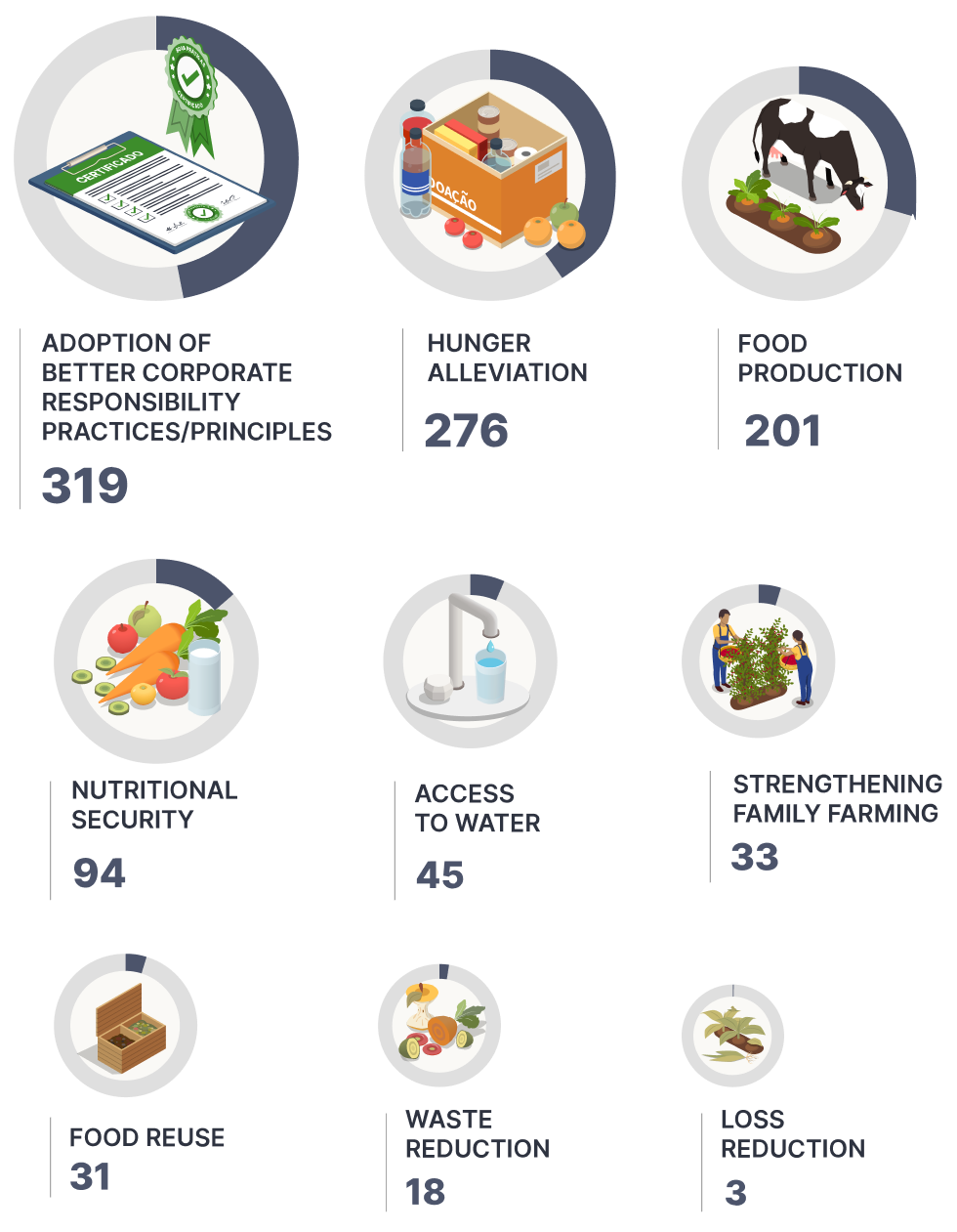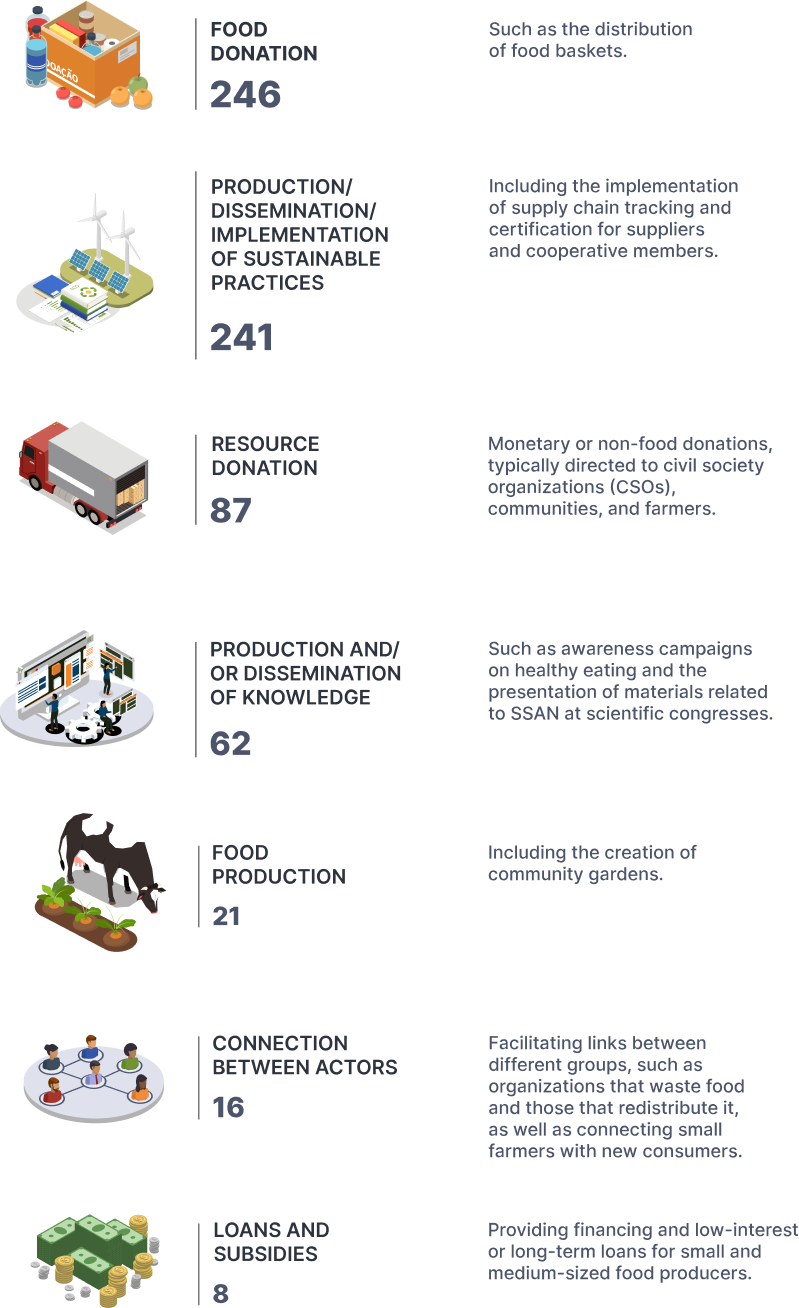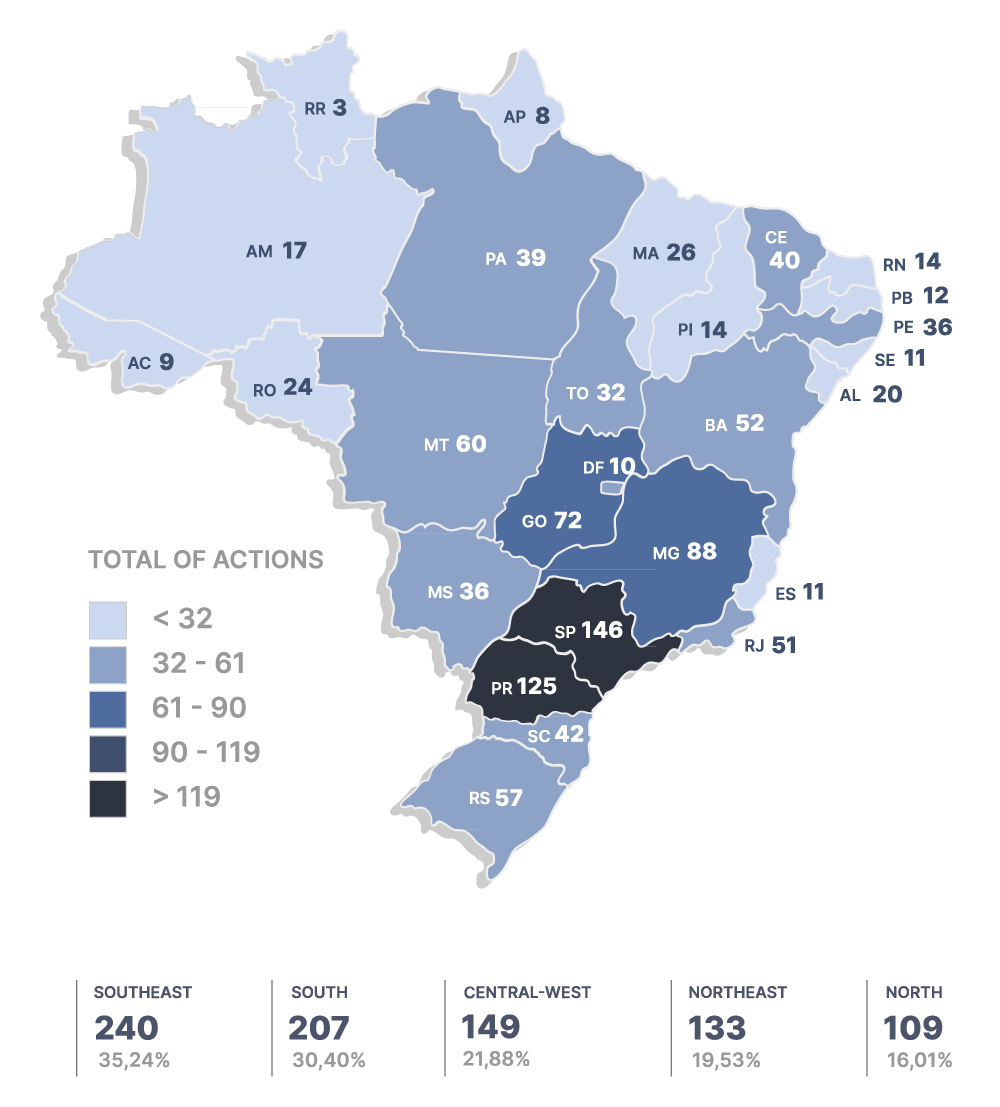
CORPORATE INVESTMENT AND SUPPORT TO ENSURE FOOD AND NUTRITION SOVEREIGNTY AND SECURITY IN BRAZIL 2020 – 2023
This research presents the mapping and analysis of socio-environmental investments and support actions undertaken by companies in the agribusiness, retail trade, and food and beverage sectors between 2020 and 2023 to promote Food and Nutrition Sovereignty and Security (FNSS) in Brazil.
HOW TO CITE THE REPORT
Rodrigues, Pietro, Laura Simões Camargo, Maria Victoria Vilela, Pedro Luiz dos Santos, and Karen Rizzato Pires. 2025. Corporate Investment and Support to Ensure Food and Nutrition Sovereignty and Security in Brazil. 01 ed. Vol. 01. São Paulo: José Luiz Setubal Foundation.
Despite consistent improvements in Brazil’s FNSS indicators between 2004 and 2014, the positive trajectory was interrupted. From 2015 to 2022, national and international changes in macroeconomic and political conditions worsened FNI levels, and, between 2021 and 2022, more than 30 million people experienced hunger (Rede PENSSAN, 2022).
However, Brazilian FNSS indicators have been improving. While the prevalence of undernutrition among the population was 4.2% between 2020 and 2022, it dropped to 3.9% between 2021 and 2023 (Hunger Map, 2025). Nationally, Brazil has taken measures such as establishing the National Strategy for Food and Nutrition Security in Cities and reinstating the National Council for Food and Nutrition Security. Internationally, as president of the G20, Brazil led discussions on FNSS and contributed to creating the Global Alliance Against Hunger and Poverty.
Nevertheless, hunger, a chronic and multifaceted problem, is not and should not be addressed by the state alone. Corporate philanthropy, for instance, has gained prominence, particularly with the rise of the Environmental, Social, and Governance (ESG) agenda. The potential ESG offers for supporting FNSS is significant, encompassing large-scale donations and the creation and maintenance of actions to combat hunger. Furthermore, large companies engage diverse stakeholders in their processes, enabling a broader variety of actions and greater reach.
Given the growing role of corporate socio-environmental responsibility and the gap in the literature regarding the contribution of Brazilian corporate philanthropy to promoting FNSS, the research defined the following question:
How did companies in the food chain contribute to ensure Food and Nutrition Sovereignty and Security in Brazil between 2020 and 2023?
681
initiatives mapped
Programs, projects, campaigns, multisectoral articulations, and organizational support
150
companies analyzed
50 from the agribusiness sector,
50 from retail trade,
50 from food and beverages.
98
companies with mapped initiatives

Research Methodology
How many actions were funded or supported by each business sector?
356 actions were funded or supported by agribusiness companies, representing 52.28% of the total 681 initiatives, 26.87% (183 actions) by food and beverage companies, and 21.29% (145 actions) by retail companies.

How were the initiatives organized?
- 472 projects – These typically had specific objectives and a focused scope, with a shorter duration than a program, often more localized and less comprehensive.
- 118 programs – Generally better structured, longer-lasting, and functioning as umbrellas encompassing various projects on the same theme.
- 73 campaigns – These usually involved the collectingon and donatingon of food during festive periods or emergencies, such as natural disasters. They also included awareness campaigns on healthy eating.
- 16 organizational supports – Actions that invested in the structure of civil society organizations by providing unrestricted donations, renovating spaces, or organizing events.
- 2 multisectoral articulations – Actions that created connections between two or more groups, such as linking family farmers with new consumers.
Who were the involved stakeholders?
- 216 suppliers or cooperative members.
- 211 communities where the company operates.
- 55 company clients.
- 34 internal employees of the company.
- 148 groups in situations of economic vulnerability.
- 126 demographic groups at higher risk of FNI exposure.
- 65 children and adolescents.
- 34 family farmers.
How did the initiatives relate to ESG benefits?
- Social – Initiatives promoting a healthy and safe workplace, fostering community and government relations, addressing human rights issues, responding to increased social pressure for improved performance, transparency, and accountability, and mitigating reputational risks. These included actions benefiting groups with a higher likelihood of FNI exposure or company stakeholders.

- Environmental – Initiatives aimed at reducing climate change risks, toxic emissions, and waste, enforcing environmental responsibility regulations, providing environmental services and sustainable products, addressing social pressure for better performance and transparency, and mitigating reputational risks.

- Governança– Iniciativas de criação de conselhos de administração e estruturas de prestação de contas, práticas responsáveis e de divulgação de informações, criação de estrutura do comitê de auditoria e independência dos auditores, transparência nas regras de remuneração dos executivos, e gestão de questões de corrupção e suborno.

What were the main objectives supported by companies?

How did the initiatives relate to the United Nations Sustainable Development Goals (SDGs)?
Considering SDG 2 “Zero hunger and sustainable agriculture” and SDG 12 “Responsible consumption and production,” the most prominent SDGs were 2.4, 2.1, and 12.6.
- The SDG 2.4 indicator had the highest number of related actions, with 311 (45,67%) initiatives. These implemented agroecological processes and practices that diversified production, introduced sustainable and resilient production practices, and developed mechanisms for better use of natural resources.
- SDG 2.1 had 289 (42,44%) initiatives that distributed food or means to access food, ensuring access to any type of food.
- SDG 12.6 accounted for the third-largest group, with 189 (27,75%) initiatives encouraging companies, cooperative members, producers, suppliers, and others to work more sustainably within the food chain.

What were the main mechanisms used?

At what stage of the food chain were the actions carried out?

What is the scope of the companies' investment and support?

Autors
Pietro Rodrigues
Pesquisador principal
Áreas de interesse: Desenvolvimento internacional; Parcerias Público-Privadas; Business State Society Relations
Laura Simões Camargo
Pesquisadora
Formação: Ciências Sociais (USP e Universidade de Melbourne)
Áreas de interesse: Soberania e Segurança Alimentar e Nutricional; Modelos de filantropia; Inteligência Artificial e Ética
Maria Victoria Vilela
Pesquisadora
Formação: Relações Internacionais (USP)
Áreas de interesse: Soberania e Segurança Alimentar e Nutricional; Mudanças Climáticas e Justiça Ambiental; Cooperação Internacional
Pedro Luiz
Pesquisador
Formação: Relações Internacionais (Ibmec)
Áreas de interesse: Soberania e Segurança Alimentar e Nutricional; Mudanças Climáticas e Justiça Ambiental; Direitos Humanos







